Microstructure and Tribological Properties of Fe-Based Laser Cladding Layer on Nodular Cast Iron for Surface Remanufacturing
Abstract
:1. Introduction
2. Materials and Experimental Study
2.1. Material and Preparation of Layers
2.2. Experimental Details
3. Results and Discussion
3.1. Microstructural Characterization of the Layers
3.2. Tribological Performance
3.3. Analysis of Worn Surface
3.4. Contact Simulation Analysis
4. Conclusions
- (1)
- When under dry sliding conditions, the wear rates of the cladding layer and nitriding layer are 1.44 × 10−6 mm3/Nm and 2.49 × 10−6 mm3/Nm, and the wear resistance values are 291.0 and 603.6 times that of QT450. The cladding layer significantly improves the wear resistance under dry sliding.
- (2)
- When under starved lubrication conditions, the friction coefficients of the cladding layer are 0.101, 0.103, and 0.097 under 100, 200, and 300 N, respectively, and it is the lowest and the most stable because of its higher contact angle. The wear rates of the cladding layer are 1.80 × 10−8 mm3/Nm, 1.96 × 10−8 mm3/Nm, and 3.53 × 10−8 mm3/Nm. The cladding layer still has excellent antifriction and wear resistance under the starved lubrication conditions.
- (3)
- The von Mises stress contours are symmetric with respect to the normal line of the contact point and diffuse outwards in an elliptical shape under the static contact conditions. However, the von Mises stress contours are inclined to the direction of relative motion as sliding started. The equivalent stress of the cladding layer is lower than that of the nitriding layer in the whole wear process, and the wear resistance of the cladding layer is excellent under dry sliding.
Author Contributions
Funding
Institutional Review Board Statement
Informed Consent Statement
Data Availability Statement
Conflicts of Interest
References
- Li, Y.; Dong, S.; Yan, S.; Liu, X.; He, P.; Xu, B. Surface remanufacturing of ductile cast iron by laser cladding Ni-Cu alloy coatings. Surf. Coat. Technol. 2018, 347, 20–28. [Google Scholar] [CrossRef]
- Zammit, A.; Abela, S.; Betts, J.C.; Grech, M. Discrete laser spot hardening of austempered ductile iron. Surf. Coat. Technol. 2017, 331, 143–152. [Google Scholar] [CrossRef]
- Nguyen Van, T.; Nguyen, T.A.; Le Thu, Q.; Pham Thi, H. Influence of plasma spraying parameters on microstructure and corrosion resistance of Cr3C2-25NiCr cermet carbide coating. Anti-Corros. Methods Mater. 2019, 66, 336–342. [Google Scholar] [CrossRef]
- Mousavi, R.; Bahrololoom, M.E.; Deflorian, F. The effect of surfactant on the microstructure and corrosion resistance of electrodeposited Ni-Mo alloy coatings. Anti-Corros. Methods Mater. 2019, 66, 631–637. [Google Scholar] [CrossRef]
- Lee, H.K.; Park, S.H.; Kang, C.Y. Effect of plasma current on surface defects of plasma-MIG welding in cryogenic aluminum alloys. J. Mater. Process. Technol. 2015, 223, 203–215. [Google Scholar] [CrossRef]
- Torims, T.; Pikurs, G.; Ratkus, A.; Logins, A.; Vilcans, J.; Sklariks, S. Development of technological equipment to laboratory test in-situ laser cladding for marine engine crankshaft renovation. Procedia Eng. 2015, 100, 559–568. [Google Scholar] [CrossRef] [Green Version]
- Emamian, A.; Corbin, S.F.; Khajepour, A. Tribology characteristics of in-situ laser deposition of Fe–TiC. Surf. Coat. Technol. 2012, 206, 4495–4501. [Google Scholar] [CrossRef]
- Wang, W.; Liu, Y.X.; Xing, F.; Xie, H.L. Laser remanufacturing technology and its applications. Adv. Mater. Res. 2010, 139, 1424–1427. [Google Scholar] [CrossRef]
- Zhao, N.; Tao, L.; Guo, H.; Zhang, M.Q. Laser clad NiCrBSi alloy wear-resistance coating with RE addition on heavy duty spur gear flank. IOP Conf.Ser. Mater. Sci. Eng. 2017, 248, 012016. [Google Scholar] [CrossRef]
- Guo, H.M.; Wang, Q.; Wang, W.J.; Guo, J.; Liu, Q.Y.; Zhu, M.H. Investigation on wear and damage performance of laser cladding Co-based alloy on single wheel or rail material. Wear 2015, 328, 329–337. [Google Scholar] [CrossRef]
- Weng, Z.; Wang, A.; Wang, Y.; Xiong, D.; Tang, H. Diode laser cladding of Fe-based alloy on ductile cast iron and related interfacial behavior. Surf. Coat. Technol. 2016, 286, 64–71. [Google Scholar] [CrossRef]
- Janicki, D. The friction and wear behaviour of in-situ titanium carbide reinforced composite layers manufactured on ductile cast iron by laser surface alloying. Surf. Coat. Technol. 2021, 406, 126634. [Google Scholar] [CrossRef]
- Li, Y.; Dong, S.; He, P.; Yan, S.; Li, E.; Liu, X.; Xu, B. Microstructure characteristics and mechanical properties of new-type FeNiCr laser cladding alloy coating on nodular cast iron. J. Mater. Pro. Technol. 2019, 269, 163–171. [Google Scholar] [CrossRef]
- Yilmaz, K.B.; Comez, I.; Yildirim, B.; Güler, M.A.; El-Borgi, S. Frictional receding contact problem for a graded bilayer system indented by a rigid punch. Int. J. Mecha. Sci. 2018, 141, 127–142. [Google Scholar] [CrossRef]
- Balci, M.N.; Dag, S. Solution of the dynamic frictional contact problem between a functionally graded coating and a moving cylindrical punch. Int. J. Solid. Sci. 2019, 161, 267–281. [Google Scholar] [CrossRef]
- Wang, S.L.; Zhang, Z.Y.; Gong, Y.B.; Nie, G.M. Microstructures and corrosion resistance of Fe-based amorphous/nanocrystalline coating fabricated by laser cladding. J. Alloy. Compd. 2017, 728, 1116–1123. [Google Scholar] [CrossRef]
- Li, Y.; Dong, S.; Yan, S.; Liu, X.; He, P.; Xu, B. Microstructure evolution during laser cladding Fe–Cr alloy coatings on ductile cast iron. Opt. Laser Technol. 2018, 108, 255–264. [Google Scholar] [CrossRef]
- Zhang, F.; Qiu, Y.; Hu, T.; Clare, A.T.; Li, Y.; Zhang, L.C. Microstructures and mechanical behavior of beta-type Ti-25V-15Cr-0.2Si titanium alloy coating by laser cladding. Mater. Sci. Eng. A 2020, 796, 140063. [Google Scholar] [CrossRef]
- Yang, Y. Microstructure and properties of laser-clad high-temperature wear-resistant alloys. Appl. Surf. Sci. 1999, 140, 19–23. [Google Scholar] [CrossRef]
- Zhang, D.; Li, Z.; Wang, L.; Kong, L.; Gao, F.; Wang, Q. Study on tribological properties of boronized and textured composite surface and its application on camshaft connecting-rod type hydraulic motor. Wear 2021, 482–483, 203964. [Google Scholar] [CrossRef]
- Cui, G.; Han, B.; Zhao, J.; Li, M. Comparative study on tribological properties of the sulfurizing layers on Fe, Ni and Co based laser cladding coatings. Tribol. Int. 2019, 134, 36–49. [Google Scholar] [CrossRef]
- Pereira, J.; Zambrano, J.; Licausi, M.; Tobar, M.; Amigó, V. Tribology and high temperature friction wear behavior of MCrAlY laser cladding coatings on stainless steel. Wear 2015, 330-331, 280–287. [Google Scholar] [CrossRef]
- Hu, D.; Liu, Y.; Chen, H.; Wang, M. Microstructure and wear resistance of Ni-based tungsten carbide coating by laser cladding on tunnel boring machine cutter ring. Surf. Coat. Technol. 2020, 404, 126432. [Google Scholar] [CrossRef]
- Hao, X.; Sun, P.; Xiao, S.; Yang, Y.; Li, L. Tribological performance of surface with different wettability under ball-on-disc test. Appl. Surf. Sci. 2020, 501, 144228. [Google Scholar] [CrossRef]
- Stevens, M.J.; Mondello, M.; Grest, G.S.; Cui, S.T.; Cochran, H.D.; Cummings, P.T. Comparison of shear flow of hexadecane in a confined geometry and in bulk. J. Chem. Phys. 1997, 106, 7303–7314. [Google Scholar] [CrossRef] [Green Version]
- Sun, M.; Ebner, C. Molecular dynamics study of flow at a fluid-wall interface. Phys. Rev. Lett. 1992, 24, 3491–3494. [Google Scholar] [CrossRef] [PubMed]
- Wei, J.; Shu-yi, L.; Zhao-gang, J. Effect of wettability of solid/liquid interface on film lubrication in line contact. Surf. Technol. 2020, 49, 252–257. [Google Scholar]
- Ma, H.; Liang, G.; Lv, M.; Huang, Y.; Han, Y. Investigation on friction and wear behavior of aisi 4340 steel in dry sliding condition. Tribology 2017, 38, 59–66. [Google Scholar]
- Arslan, O. Hertz-type frictional contact problem of a bidirectionally graded half-plane indented by a sliding rounded punch. Mech. Mater. 2020, 149, 103539. [Google Scholar] [CrossRef]
- Kraghelsky, I. Calculation of wear rate. J. Bas. Eng. 1965, 87, 785. [Google Scholar] [CrossRef]
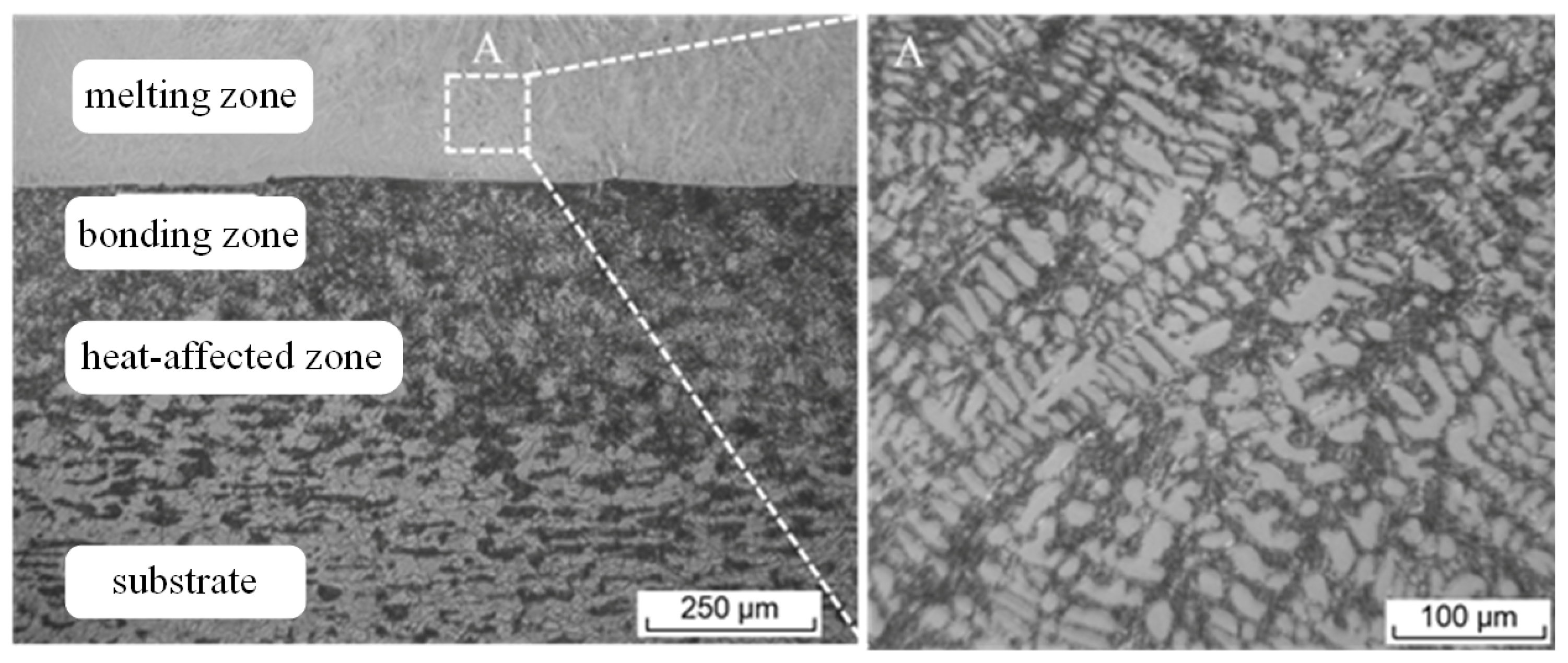
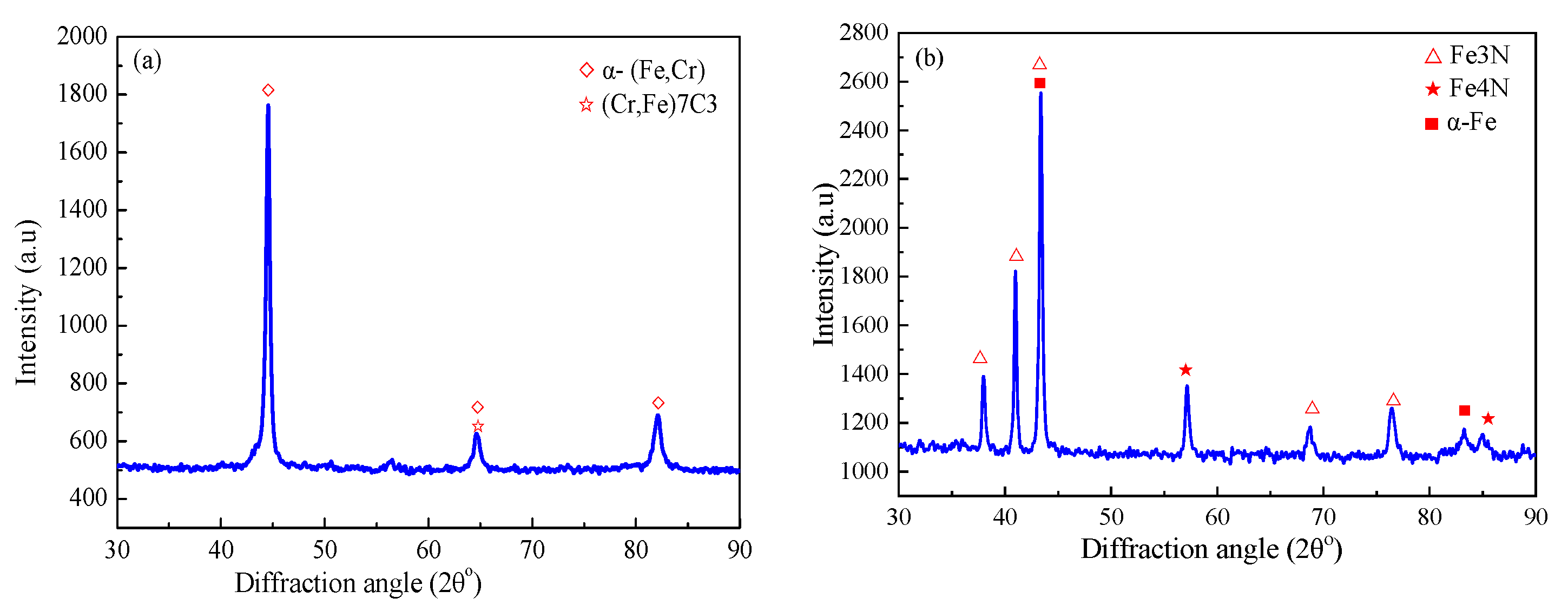
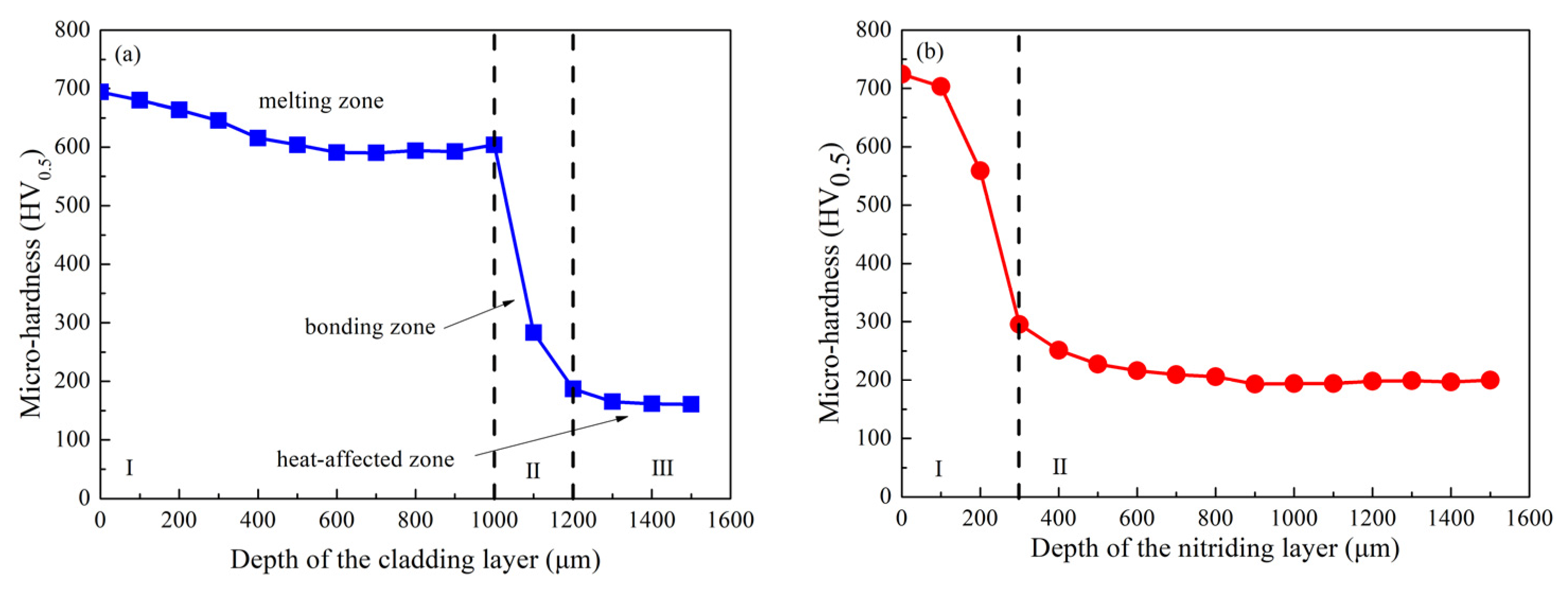




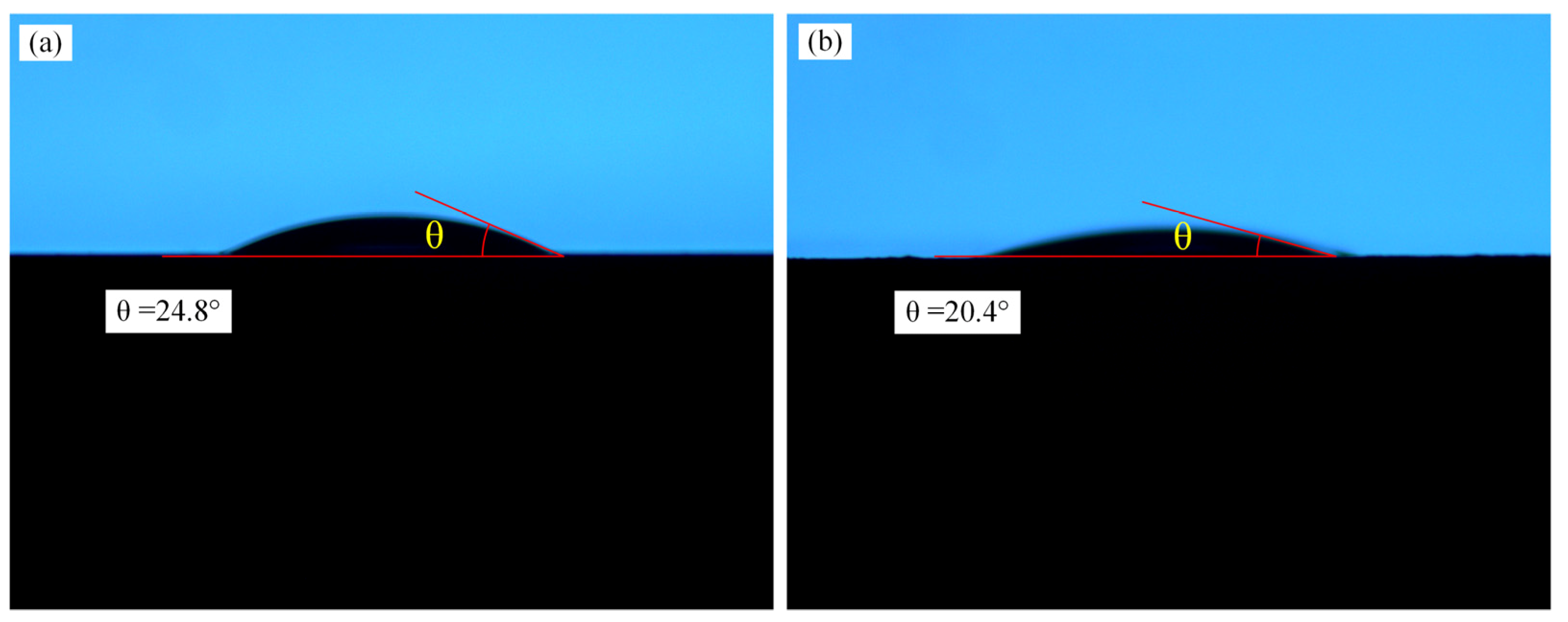


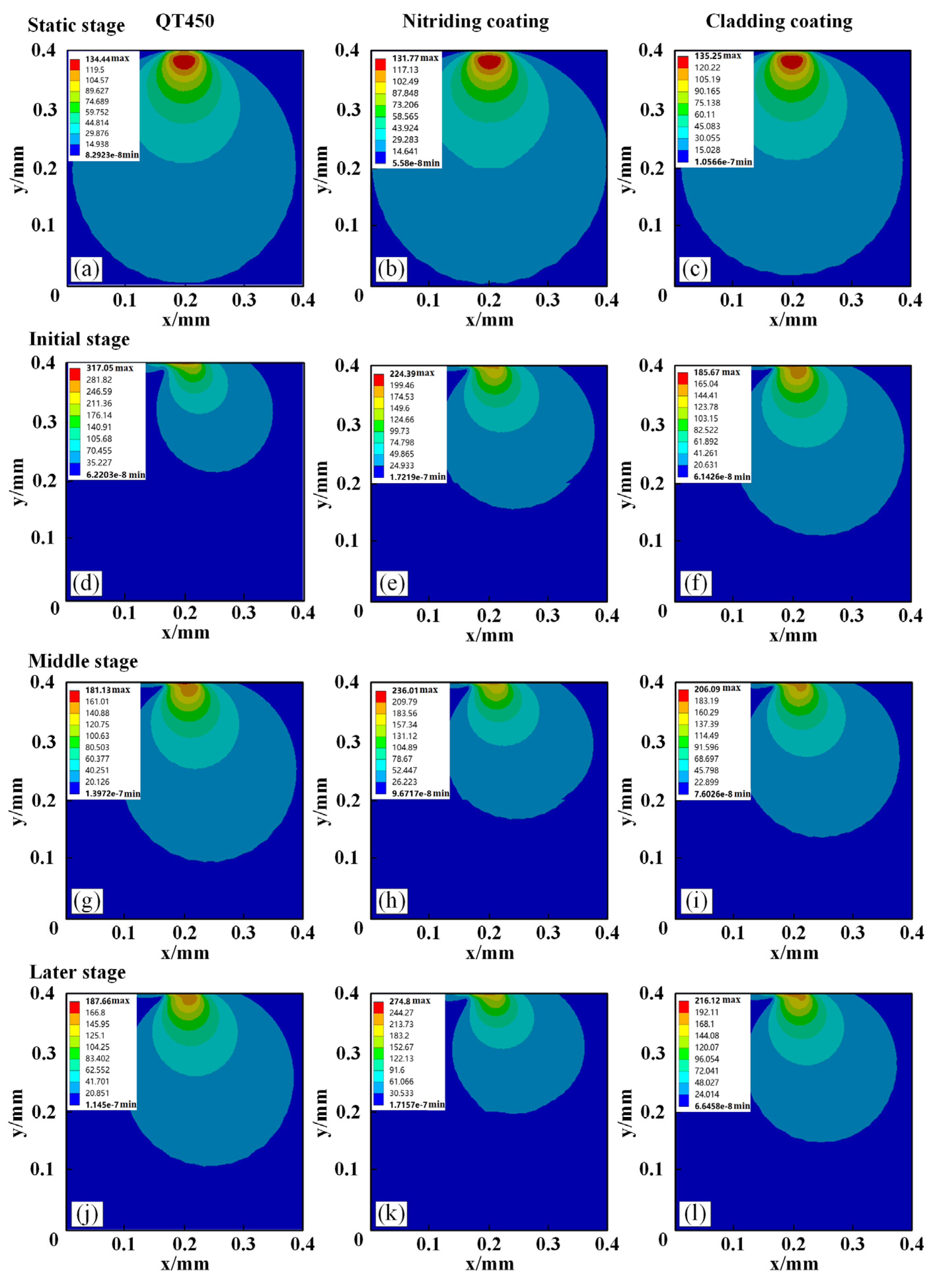
| Elements | C | Si | Cr | Fe |
|---|---|---|---|---|
| Content wt.% | 1.2 | 2.2 | 14.3 | Balance |
| Elements | C | Cr | Ni | Mn | Si | S | Fe |
|---|---|---|---|---|---|---|---|
| Content wt.% | 0.035 | 17.7 | 0.26 | 1.25 | 0.41 | 0.015 | Balance |
| Test Condition | Sliding Stroke | Applied Load | Frequency | Test Time |
|---|---|---|---|---|
| Dry sliding | 5 mm | 10 N | 2 Hz | 3 h |
| Starved lubrication | 5 mm | 100, 200, 300 N | 2 Hz | 3 h |
| Materials | Elastic Modulus (GPa) | Poisson’s Ratio |
|---|---|---|
| 304 stainless steel ball | 206 | 0.30 |
| QT450 | 169 | 0.26 |
| Cladding layer | 220 | 0.30 |
| Nitriding layer | 220 | 0.30 |
| Stages | Initial Stage | Middle Stage | Later Stage |
|---|---|---|---|
| QT450 | 0.72 | 0.34 | 0.36 |
| Cladding layer | 0.38 | 0.44 | 0.47 |
| Nitriding layer | 0.47 | 0.50 | 0.60 |
Publisher’s Note: MDPI stays neutral with regard to jurisdictional claims in published maps and institutional affiliations. |
© 2021 by the authors. Licensee MDPI, Basel, Switzerland. This article is an open access article distributed under the terms and conditions of the Creative Commons Attribution (CC BY) license (https://creativecommons.org/licenses/by/4.0/).
Share and Cite
Zhang, D.; Li, Z.; Fan, H.; Rui, H.; Gao, F. Microstructure and Tribological Properties of Fe-Based Laser Cladding Layer on Nodular Cast Iron for Surface Remanufacturing. Coatings 2021, 11, 974. https://doi.org/10.3390/coatings11080974
Zhang D, Li Z, Fan H, Rui H, Gao F. Microstructure and Tribological Properties of Fe-Based Laser Cladding Layer on Nodular Cast Iron for Surface Remanufacturing. Coatings. 2021; 11(8):974. https://doi.org/10.3390/coatings11080974
Chicago/Turabian StyleZhang, Dongya, Zhongwei Li, Hongwei Fan, Hongbin Rui, and Feng Gao. 2021. "Microstructure and Tribological Properties of Fe-Based Laser Cladding Layer on Nodular Cast Iron for Surface Remanufacturing" Coatings 11, no. 8: 974. https://doi.org/10.3390/coatings11080974






